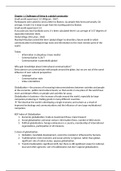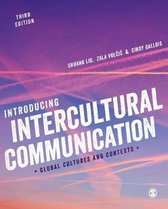Chapter 1. Challenges of living in a global community
Small world experiment 1.0 (Milgram, 1967)
Participants were asked to send a letter to Boston, via people they know personally. On
average, it took 5 to 6 steps to get from the starting point to Boston.
Small world experiment 2.0
If you pick any two Facebook users, it’s been calculated there’s an average of 3.57 degrees of
separation between them.
Global village (McLuhan, 1962)
Marshal McLuhan coined the term ‘global village’ to describe a future world in which
communication technology brings news and information to the most remote parts of the
world.
Today:
- Information is ubiquitous (mass media)
- Communication is 24/7
- Communication is potentially global
Why gain knowledge about intercultural communication?
Every person can communicate with people around the globe, but we are not all the same!
Influence of own cultural perspective:
- Language
- Communication style
- Value orientations
Globalization = the process of increasing interconnectedness between societies and people
at the economic, politics land cultural levels, so that events in one place of the world have
more and deeper effects on people and societies far away.
Globalization in business = the increase of trade around the world, especially by large
companies producing or trading goods in many different countries.
The idea that the world is developing a single economy and culture as a result of
improved technology and communications and the influence of very large multinational
companies.
KOF Index of Globalization
1. Economic globalization: trade & investment flows, import/export
2. Social globalization: personal contact, information flows, number of IKEA stores
3. Political globalization: foreign embassies in a country, membership of international
organizations, participation in UN missions
3 views of globalization:
1. Globalists: inevitable development, cannot be resisted or influenced by humans.
2. Traditionalists: most economic and social activity is regional, rather than global,
significant role of nation-states; oppose globalization.
3. Transformationalists: significant shift, but there is still significant scope for national,
local and other agencies; sort of traditionalist, but don’t oppose globalization.
, Is globalization leading to a more diversified or a more uniform world?
Where do we see greater diversity as a result of globalization and where do we see more
uniformity?
Today: 5000 distinct languages/cultures & 300 distinct phyla (= ethnolinguistic families)
Biological and cultural diversity go together! Areas with an extensive flora and fauna are
likely to offer a place to survive for a greater amount of people.
Environmental factors: geographical barriers breed divergence tropical climates support
more life, e.g. two groups of people who live on two different sides of a huge mountain.
Sociocultural factors: smaller groups are highly adaptable, multilingualism is the global norm.
Contributors to cultural contact:
- Advanced technology and transportation
- Increased mobility
o Easier to travel & move for economic or lifestyle opportunities
o Easier to interact online via ever-changing apps & modalities
o Smaller, yet more diverse world
Understanding other cultures is a challenge we face on an everyday basis!
- Global economy
- International business transactions
o Global transformation: local market as diverse as global market
o International expansion: MNCs operating globally, outsourcing to low-wage
countries
o Diverse workforce: migrant workers, expats
Understanding cultural tensions created by economic transformations is a
challenge we face in the intercultural communication in business contexts (BREXIT).
- Mass migration
- International exchange/education (5% of global population is mobile)
o Immigrant flows, from developing to developed countries
o Refugees from war-torn countries
o Migrant workers who move to a host country temporarily
o Student exchanges
o Expats who temporarily relocate to work in another country
Facilitating intercultural co-existence is a challenge we face in our society!
Necessity and benefits of intercultural communication:
Multiculturalism (1) = a society made up of diverse cultures (descriptive level).
Society’s tolerance towards diversity and acceptance of equal societal participation.
- Living and working together requires tolerance and mutual understanding.
- ‘Melting pot’ societies flourish when there is acceptance of equal societal
participation of diverse groups.
Therefore: necessary to study intercultural communication and gain international
communicative competence. (attitudinal level)
Building intercultural understanding (2)
- Become aware of cultural rules (own + others’) by being confronted with cultural
rules of others.
,Promoting international business exchange (3)
- Communicating with unfamiliar cultures does not simply mean finding a translator.
- Business is building relationships. (Chinese guanxi: trust, favour, dependence,
adaptation)
Therefore: understanding cultures and cultural differences is the key to successful business
exchange.
Facilitating cross-cultural adaptation (4)
- The tension between immigrants and host nationals often centres on the issues of
cultural maintenance – melting pot or salad bowl?
Fractionation = the divisive separation of people.
Intercultural communication can help us to build our knowledge of other people and their
cultures, as well as enhancing and consolidating our knowledge about our own culture. The
result is invariably greater intercultural understanding.
President Xi Jinping
“In today’s world, all countries are interdependent and share a common future.”
A China Daily
“Intercultural communication can play an irreplaceable role in this historical undertaking.”
QUIZ
1. Marshal McLuhan ‘global village’ originally referred to what phenomenon?
B. The way in which communication technology was bringing remote areas of the
globe together.
2. What are some contributors to cultural diversity?
Communication technology, educational exchange, modern transport systems,
international business, mass migration.
, Chapter 2. Culture and people
Culture and communication are intertwined, because we learn culture through
communication. It is difficult to have a concrete definition of culture because the
characteristics that we use to denote cultural differences are not universally applicable.
Many different definitions in scientific literature. In common:
- Culture is pervasive in human life (= everywhere, framework you live by).
- Culture governs people’s behaviours.
Culture = the particular way of life of a group of people.
Culture is develop, manifested, shared and maintained through communication.
Metaphors for culture:
- People see the world through cultural glasses.
- People see the world through a window.
- Culture is the luggage we carry.
- Culture is like the water fish swim in.
- Culture is like the air we breathe.
- Web that people have spun.
- Iceberg (Hall, 1973)
- Onion (Hofstede)
o Superficial to deep (symbols heroes rituals values)
- Software of the mind
o Culture as hardwired program in our mind
o Needs to be installed
- Tree
o Bottom to up
o Fundamental concerns – values – outward expressions
o Dynamic
- Pot of jelly beans
o Cultures are individual, yet, they work together with other cultures to
produce an even better combination.
Components of culture
Culture = the particular way of life of a group of people and the meaning-making process by
which people make sense of their social world. Culture comprises the deposit of knowledge,
experience, beliefs, values, traditions, religion, notions of time, roles, spatial relations,
worldviews, material objects and geographic territory.






